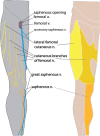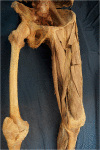Use of a Digital, Profession-Specific Dissection Guide Is Associated with Improved Examination Performance and Student Satisfaction
- PMID: 34457764
- PMCID: PMC8368761
- DOI: 10.1007/s40670-020-01000-4
Use of a Digital, Profession-Specific Dissection Guide Is Associated with Improved Examination Performance and Student Satisfaction
Abstract
Anatomical knowledge is requisite for effective physical therapy (PT) practice. Cadaver dissection is a popular teaching method employed in PT anatomy courses. Limited time in the laboratory requires effective dissection instructions. Several limitations of a printed, non-discipline specific dissection guide have been identified by students and instructors in anatomy curricula. The objective of this project was to evaluate the effect of using a digital, PT specific dissection guide on examination performance and student satisfaction. A digital guide was developed that incorporated improvements based on observations of student experiences using a printed guide. The digital guide covered two lower extremity regional dissections and was distributed for use during the summer 2017 course. Enhancements included clarification of dissection procedures, formative quizzes, image galleries, embedded videos, and a glossary of terms. Students used a printed guide for all other dissections in the course. The percentage of correct answers from practical examinations was calculated and compared between summer of 2015 (print) and 2017 (digital) courses. A survey consisting of nineteen five-point Likert items was distributed. The percentage of correct answers was significantly higher for the digital guide (91.7 ± 7.11%) compared with the print guide (84.2 ± 9.51%, P < 0.0001). On the survey, the median item rating was strongly agree for two, agree for fifteen, and neither agree or disagree for two. These results suggest that developing a curriculum specific, digital guide was effective in improving student knowledge and satisfaction. These results encourage development of additional content specific guides in a digital format.
Keywords: Digital assets; Dissection guide; Gross anatomy laboratory; Learning outcomes; Technology-enhanced learning; eBook.
© International Association of Medical Science Educators 2020.
Conflict of interest statement
Conflict of InterestThe authors declare that they have no conflict of interest.
Figures





Similar articles
-
Evaluating dissection in the gross anatomy course: Correlation between quality of laboratory dissection and students outcomes.Anat Sci Educ. 2015 Jan-Feb;8(1):45-52. doi: 10.1002/ase.1458. Epub 2014 May 2. Anat Sci Educ. 2015. PMID: 24799441
-
Analysis of traditional versus three-dimensional augmented curriculum on anatomical learning outcome measures.Anat Sci Educ. 2016 Nov;9(6):529-536. doi: 10.1002/ase.1612. Epub 2016 Apr 14. Anat Sci Educ. 2016. PMID: 27078503
-
Experience from an optional dissection course in a clinically-orientated concept to complement system-based anatomy in a reformed curriculum.Anat Sci Educ. 2018 Jan;11(1):32-43. doi: 10.1002/ase.1707. Epub 2017 Jun 13. Anat Sci Educ. 2018. PMID: 28608954
-
Cadaveric dissection as an educational tool for anatomical sciences in the 21st century.Anat Sci Educ. 2017 Jun;10(3):286-299. doi: 10.1002/ase.1649. Epub 2016 Aug 30. Anat Sci Educ. 2017. PMID: 27574911 Review.
-
Best teaching practices in anatomy education: A critical review.Ann Anat. 2016 Nov;208:151-157. doi: 10.1016/j.aanat.2016.02.010. Epub 2016 Mar 17. Ann Anat. 2016. PMID: 26996541 Review.
Cited by
-
The effect of Snapchat on learner satisfaction and anatomical knowledge retention: Preliminary observations.FASEB Bioadv. 2021 Aug 27;3(11):909-917. doi: 10.1096/fba.2021-00052. eCollection 2021 Nov. FASEB Bioadv. 2021. PMID: 34761173 Free PMC article.
-
Protocol Development for Digisection: Making a Case for Standardizing Educational Technology Use for Digital Dissection and Anatomical Studies.Cureus. 2023 Mar 4;15(3):e35766. doi: 10.7759/cureus.35766. eCollection 2023 Mar. Cureus. 2023. PMID: 37020488 Free PMC article.
References
-
- Ogard WK. Outcomes related to a multimodal human anatomy course with decreased cadaver dissection in a doctor of physical therapy curriculum. J Phys Ther Educ. 2014;28(3):21–26. doi: 10.1097/00001416-201407000-00004. - DOI
-
- Weddle ML, Sellheim DO. An integrative curriculum model preparing physical therapists for vision 2020 practice. J Phys Ther Educ. 2009;23(1):12–21. doi: 10.1097/00001416-200901000-00003. - DOI
LinkOut - more resources
Full Text Sources
